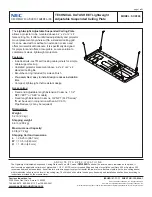
229 Heat Dissipation Matric Water Potential Sensor
20
significant advantage for this method over normalization as described by equation
[3].
A calibration equation using
norm
T
Δ
and having a form similar to equation [2] is
β
α
ψ
+
Δ
=
norm
T
*
|)
ln(|
. [4]
The slope of equation [2] will be positive while the slope of equation [4] will be
negative.
6.2.2 Correction for Soil Temperature
The heat dissipation method of matric potential measurement is sensitive to
temperature and correction for the temperature dependence may be necessary to
maintain accuracy of the measurement. If the soil temperature when the matric
potential measurements are made is close to the temperature at the time of sensor
calibration there is no need for correction.
The 229 measurement method uses heat transfer away from a heated line source
and the heat transfer depends on the thermal conductivity of the ceramic. The
thermal conductivity of the ceramic depends on the combination of the
conductivities of water, vapour and solid constituents. The vapour component has
a strong temperature dependence and consequently imparts sensitivity of the
measurement to temperature. The sensitivity is related to the difference between
the temperature of the sensor at time of measurement (soil temperature) and the
temperature of the sensor during calibration. Figures 6-2 and 6-3 show the
response of the matric potential measurement for a range of temperatures when the
calibration temperature is 20°C.








































